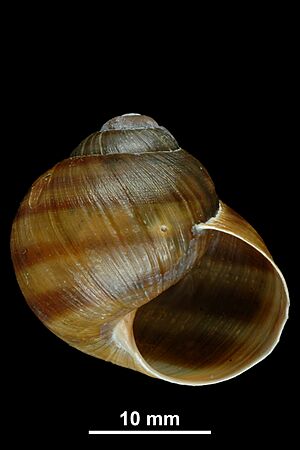Corsican snail facts for kids
The Corsican snail, also known as Helix ceratina, is a special type of land snail. It's a small mollusk that breathes air, just like us! It belongs to the Helicidae family, which includes many common snails.
Quick facts for kids Corsican snail |
|
|---|---|
 |
|
| Shell of Helix ceratina (specimen at MNHN, Paris) | |
| Conservation status | |
| Scientific classification | |
| Genus: |
Helix
|
| Species: |
ceratina
|
| Synonyms | |
|
|
Contents
What Does It Look Like?
The Corsican snail is quite small for a Helix snail. Its shell can grow up to 24 millimeters wide. That's about the size of a large coin! The shell is usually olive-brown with darker stripes. It also has thin walls.
Where Does It Live?
This snail is endemic to Corsica, an island in France. This means it lives naturally only in Corsica and nowhere else in the world!
Its Special Home
Today, the only known group of these snails lives in a small area called Campo dell’Oro. This spot is very close to the Ajaccio airport. The area where they live is tiny, only about 0.34 square kilometers.
Snails from the Past
Even though they live in a small area now, these snails used to be found in more places. Scientists have found their fossil shells in three other coastal locations in Corsica. Some of these fossils are from the Neolithic period, which was thousands of years ago! Despite many searches since the 1990s, no other living groups of these snails have been found.
Snail Habits
The Corsican snail lives in sandy areas near the coast. These spots often have special plants like Crucianella maritima and Genista salzmannii. The snails like places where the plants are not too dense. They also prefer surfaces that are not covered by lichens.
When Are They Active?
These snails are mostly active at night. They come out from October to June, especially when it rains. During hot and dry times, they are very clever! They dig deep into the soil, sometimes up to 60 centimeters (about 2 feet) down. There, they create a hard, chalky cover called an epiphragm to protect themselves from drying out.
Life Cycle of the Snail
Scientists have watched these snails in captivity to learn about their lives.
Mating and Eggs
Mating usually happens from late August to mid-October. A few days after mating, the snails lay their eggs. The eggs are quite large, about 5-7 millimeters wide, and have an oval shape. A snail can lay between 6 and 19 eggs at a time. They lay these eggs in nests they dig underground.
Hatching and Young Snails
The eggs hatch after about 15-16 days. When the baby snails are born, their shells are already about 5-6 millimeters wide.
What Do They Eat?
The diet of the Corsican snail changes with the seasons.
Seasonal Meals
In the spring, they enjoy eating fresh leaves. But in the autumn, they switch to eating decaying plant matter. The plant Genista salzmannii is a very important part of their diet. It's found in 80% of their droppings! They also eat other plants like Matthiola sinuata, Jasione montana, and different types of grasses. In captivity, they were even seen eating sand from their environment.


